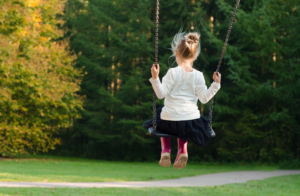July 1, 2022
By Angelica Ly, BOptom (Hons), GradCertOcTher, PhD, FAAO, Principal Research Optometrist at the Brien Holden Vision Institute
Importantly, increased outdoor time can also “offset” the impact of parental myopia and high levels of near work, and the effect seems independent of sports activity levels.
 How bright a day does it need to be? Does it matter what my child is doing? Does it matter if my child is already myopic, or if their myopia is rapidly progressing or only slowly progressing? Is bright, artificial light a possible substitute? Does wearing UV protection lower the effect?
How bright a day does it need to be? Does it matter what my child is doing? Does it matter if my child is already myopic, or if their myopia is rapidly progressing or only slowly progressing? Is bright, artificial light a possible substitute? Does wearing UV protection lower the effect?
Parents and children can be a challenging group for optometrists to manage. Parents often come to us with a myriad of reasonable questions, seeking answers when conclusive evidence simply isn’t always available.
What Do We Know About Outdoor Time and Myopia?
The International Myopia Institute White Papers II 2021 series reported a strong and consistently observed causal association between time outdoors and less myopia, drawing from data derived from cross-sectional, ecological, longitudinal studies, and meta-analyses.1,2 Importantly, increased outdoor time can also “offset” the impact of parental myopia and high levels of near work, and the effect seems independent of sports activity levels.3,4
According to the experts, time outdoors is also the only protective factor to have been translated into a “proven preventative intervention,” with clinical trials showing significant reductions in incident myopia, e.g., an absolute difference of 9.1% in the three-year cumulative incident rate of myopia among 6-year-old children in China, after an extra 40 minutes exposure to outdoor time per school day.5
A detailed discussion of the mechanisms relating to increased outdoor time and less myopia is beyond the scope of this article, but it is an important consideration before we can accept the association as causal. In brief, the leading hypothesis is that outdoor light stimulates the release of dopamine in the retina, which retards axial elongation. Other plausible alternative hypotheses highlight a potentially important role of vitamin D, variations in defocus, spatial frequency profiles, and/or a more uniform plane of dioptric power outdoors versus indoors.6
How Much is Enough? Measuring Outdoor Time and the Dose-Response Relationship
To answer this question, an essential detour is to first consider how outdoor time is measured. Early works relating refraction and outdoor time were based on occupational classification captured via written questionnaires in adults, e.g., farmers and agricultural workers versus people in managerial positions.7 Such questionnaires gradually became more targeted, probing parents to respond on behalf of their children regarding the average amount of time spent daily on outdoor activities,8 hours per week outside of school spent engaging in sports or outdoor activities, in the context of other activities,3,9 or average hours per day spent (to the nearest half-hour) on specific activities (e.g., outdoor sport, playing outside, picnics, and walking), allowing for separate responses to weekdays versus weekends.4,10 The latter has been validated against 24-hour diaries.11
However, as with all questionnaires, the data may be subject to inaccuracies due to self-reporting, recall bias, social desirability bias, and/or satisficing by participants. Alternatively, objective methods of measuring outdoor time rely on wearable technology, including devices with inbuilt light meters or global positioning systems. Secondary biomarkers such as vitamin D and conjunctival ultraviolet autofluorescence have also been explored.
Limitations of the data aside, a recent systematic review and meta-analysis2 showed that the odds of incident myopia are significantly higher for individuals who spend ≤13 hours per week (i.e., less than two hours per day) when compared to individuals who spend >22.5 hours per week (greater than 3.2 hours per day) outdoors. The same work revealed that increasing a child’s outdoor time by approximately 76 minutes per day will reduce their risk of incident myopia by 50%. The dose-response relationship was approximately linear and inverse with an r-squared of 0.586, indicating that approximately 60% of the variability observed in incident myopia may be attributed to increased time outdoors.
What Levels of Light Intensity are Sufficient to Have an Effect?
The exact levels of light intensity required to induce an effect remain unclear. Historically, epidemiological studies defined outdoor time as light intensities over 1,000 lux. Light intensities between 2,000 and 5,000 lux may be effective at preventing the onset of myopia in humans. By comparison, standard well-lit room environments typically range between 500-1,000 lux, while outdoor levels vary between 10,000-130,000 depending on weather, geography, and elevation. Other questions regarding the duration, timing, and frequency are reasonable to ask; however, the evidence is similarly still emerging.1
Does Increased Time Outdoors Reduce Progression?
Perhaps; however, more definitive data is required. The same systematic review and meta-analysis described above showed that while increased time outdoors is effective in preventing the onset of myopia, it was “not effective in slowing progression in eyes that were already myopic.”2
Making Recommendations About Outdoor Time in the Consulting Room
Translating the evidence above to an understandable and actionable message for parents and their children can be challenging. Some frequently asked questions and answers are supplied below, which may be used as a non-prescriptive starting point for eye care professionals.
FREQUENTLY ASKED QUESTIONS
- How much outdoor time do children require to prevent myopia?
At least two hours per day, and the more the better. - How bright a day does it need to be? Is bright, artificial light a possible substitute? Even a cloudy, overcast day delivers light intensities well beyond a standard well-lit room indoors. Indoor sport does not deliver the same myopia-preventing benefits as outdoor time.
- Does it matter what my child is doing?
In short, no, but aim for far viewing distances, and consider the added benefits of outdoor exercise on a child’s physical and mental health. - Will outdoor time help my child who is already myopic? Is there any point if they are destined to become myopic based on their family history and their bookworm nature?
We don’t know; however, the physical and mental health benefits of time outdoors are reason enough for children to spend time outdoors. Even children with high levels of near work and a strong family history of parental myopia seem to benefit. - Does wearing UV protection lower the effect?
Light outdoors is still many magnitudes more intense than indoor light; sun protection is essential, and your child will still benefit. - Where can I get more information? How do I get started?
A helpful starting point is to use evidence-based, freely available online resources such as Outdoor Play and Short-sightedness.
 |
Angelica Ly, BOptom (Hons), GradCertOcTher, PhD, FAAO, is a clinician-scientist who strives to be a supporting resource to eye care professionals to gain and share knowledge so that they may deliver the best possible care to their patients. She has co-authored 30 peer-reviewed journal articles and presents regularly at both national and international conferences. |
References
- Morgan, I.G., et al., IMI Risk Factors for Myopia. Investigative Ophthalmology & Visual Science, 2021. 62(5): p. 3-3.
- Xiong, S., et al., Time spent in outdoor activities in relation to myopia prevention and control: a meta-analysis and systematic review. Acta Ophthalmol, 2017. 95(6): p. 551-566.
- Jones, L.A., et al., Parental history of myopia, sports and outdoor activities, and future myopia. Invest Ophthalmol Vis Sci, 2007. 48(8): p. 3524-32.
- Rose, K.A., et al., Outdoor activity reduces the prevalence of myopia in children. Ophthalmology, 2008. 115(8): p. 1279-85.
- He, M., et al., Effect of Time Spent Outdoors at School on the Development of Myopia Among Children in China: A Randomized Clinical Trial. Jama, 2015. 314(11): p. 1142-8.
- French, A.N., et al., Time outdoors and the prevention of myopia. Exp Eye Res, 2013. 114: p. 58-68.
- Pärssinen, T.O., Relation between refraction, education, occupation, and age among 26- and 46-year-old Finns. Am J Optom Physiol Opt, 1987. 64(2): p. 136-43.
- Hemminki, E. and O. Pärssinen, Prevention of myopic progress by glasses. Study design and the first-year results of a randomized trial among schoolchildren. Am J Optom Physiol Opt, 1987. 64(8): p. 611-6.
- Mutti, D.O., et al., Parental myopia, near work, school achievement, and children’s refractive error. Invest Ophthalmol Vis Sci, 2002. 43(12): p. 3633-40.
- Rose, K.A., et al., Myopia, lifestyle, and schooling in students of Chinese ethnicity in Singapore and Sydney. Arch Ophthalmol, 2008. 126(4): p. 527-30.
- Saw, S.M., et al., Estimating the magnitude of close-up work in school-age children: a comparison of questionnaire and diary instruments. Ophthalmic Epidemiol, 1999. 6(4): p. 291-301.













